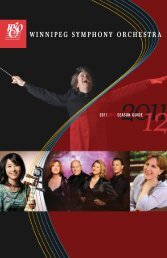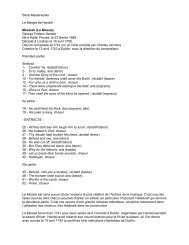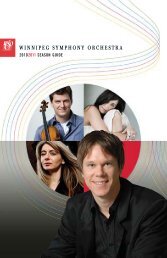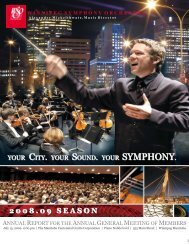Issue 1: September – October - Winnipeg Symphony Orchestra
Issue 1: September – October - Winnipeg Symphony Orchestra
Issue 1: September – October - Winnipeg Symphony Orchestra
You also want an ePaper? Increase the reach of your titles
YUMPU automatically turns print PDFs into web optimized ePapers that Google loves.
PROGRAM NOTES<br />
by James Manishen<br />
Violin Concerto No. 1<br />
Dmitri Shostakovich<br />
b. St Petersburg, Russia / <strong>September</strong><br />
25, 1906<br />
d. Moscow / August 9, 1975<br />
Composed: 1947-48<br />
First performance: <strong>October</strong> 29, 1955<br />
(Leningrad) conducted by Yevgeny<br />
Mravinsky with David Oistrakh as soloist<br />
Last WSO performance: 1993, Cho-<br />
Liang Lin, violin; Bramwell Tovey,<br />
conductor<br />
It was déjà vu for Shostakovich in<br />
1948 as he composed his Violin<br />
Concerto No. 1. He had felt the<br />
purge in 1936 when his opera Lady<br />
Macbeth of Mtsensk was called<br />
“muddle” by Soviet officialdom.<br />
Again, he was condemned in 1948 in<br />
the general purge by the authorities<br />
to ban abstract or difficult music that<br />
might be challenging for the Soviet<br />
people to accept. Only simple music<br />
glorifying the State would be allowed.<br />
Shostakovich knew both purges had<br />
come from Stalin.<br />
After the 1936 purge, he responded<br />
with his magnificent Fifth <strong>Symphony</strong><br />
and soon became a world figure. But<br />
the 1948 censure was too much to<br />
bear, and he decided to withhold<br />
releasing any of his substantial works<br />
for a fair hearing until after Stalin was<br />
out of the picture. Stalin’s death on<br />
March 5, 1953 <strong>–</strong> the same day as<br />
Prokofiev’s <strong>–</strong> was like a dam bursting<br />
for Shostakovich. His Violin Concerto<br />
No. 1 waited until 1955 for its<br />
premiere by David Oistrakh, who had<br />
worked on the score with<br />
Shostakovich and was one of the<br />
greatest violinists of the time.<br />
Shostakovich’s alleged memoirs<br />
Testimony reveal that the genesis of<br />
the Concerto came from a combined<br />
bond to Jewish folklore plus the<br />
moral issue of what had happened to<br />
the Jews during the terror of the<br />
Second World War. Shostakovich was<br />
deeply affected by the Holocaust yet<br />
also by what he called the<br />
multifaceted flavour and spirit of<br />
18 OVERTURE I <strong>September</strong> <strong>–</strong> <strong>October</strong> 2011<br />
Jewish music, its ability to “be happy<br />
while it is tragic…almost always<br />
laughter through tears.” As always in<br />
Shostakovich’s major works, the<br />
symphonic argument is powerful,<br />
compelling and plotted with airtight<br />
logic. In this concerto too, his initials<br />
become a musical signature: D, E-flat<br />
(German S), C, H (German B-natural).<br />
In the opening Nocturne, the solo<br />
violin grows continuously from the<br />
dark string melody underneath, the<br />
centre-piece of the movement, a<br />
powerful statement leading to the<br />
return of the quieter opening<br />
material to close. The wild Scherzo<br />
couldn’t be more different, recalling<br />
the similar one in the Tenth<br />
<strong>Symphony</strong>, a work Shostakovich<br />
called “about Stalin.” The<br />
Passacaglia uses the ancient<br />
variation form of a repeating theme<br />
layering increasingly elaborate<br />
material on top, with deeply moving<br />
results. The Finale is a stunning<br />
virtuosic display that encapsulates<br />
previous material to close this<br />
brilliant, complex yet most<br />
accessible masterwork.<br />
Hamlet: Incidental Music<br />
Dmitri Shostakovich<br />
Composed: 1932<br />
First WSO performance<br />
Shostakovich loved<br />
Shakespeare’s Hamlet<br />
and studied it<br />
comprehensively over<br />
many years. His first<br />
supporting music was<br />
for a notorious production by<br />
Nikolai Akimov in 1932. Here,<br />
Hamlet was a revolutionary fighting<br />
with the authorities - not for his<br />
ideals but for personal gain - Ophelia<br />
an alcoholic nymphomaniac, and<br />
Elsinore as the morally bankrupt<br />
state. Naturally, the production was<br />
shut down and Shostakovich refused<br />
to be associated with Hamlet until<br />
composing a completely different<br />
score for a traditional production in<br />
1954 and a film in 1964. His 1932<br />
score has much to enjoy though, with<br />
nods to Russian ballet plus the<br />
famous Dies Irae chant in the<br />
Requiem.<br />
<strong>Symphony</strong> No. 9<br />
Dmitri Shostakovich<br />
Composed: 1945<br />
First performance: November 3, 1945<br />
(Leningrad) conducted by<br />
Yevgeny Mravinsky<br />
Last WSO performance: 1991,<br />
Bramwell Tovey, conductor<br />
Begun in 1941, Shostakovich’s large-scale<br />
<strong>Symphony</strong> No. 7 reflects the siege of<br />
Leningrad, a Leningrad “Stalin destroyed<br />
and Hitler finished off,” the composer<br />
wrote in Testimony. Shostakovich’s<br />
<strong>Symphony</strong> No. 8 (1943) is a profoundly<br />
tragic and epic depiction of massive<br />
conflict and the war’s consequences. With<br />
victory over Hitler’s Nazis in 1945, the<br />
resulting expectation for Russia’s greatest<br />
composer was to provide a suitably<br />
monumental symphony to glorify Stalin in<br />
no uncertain terms, regardless of the<br />
terrible losses of the Russian people. After<br />
all, Beethoven and Mahler wrote<br />
auspicious Ninth symphonies. So too here,<br />
but with a more significant dedication the<br />
politburo felt.<br />
Shostakovich did attempt an epic first<br />
movement but abandoned it, observing<br />
Stalin “like a frog puffing himself up to<br />
the size of the ox. Everyone praised<br />
Stalin and now I was supposed to join in<br />
this unholy affair.”<br />
Shostakovich’s response was a far more<br />
compact symphony in the new Ninth <strong>–</strong><br />
full of biting wit, economy of gesture<br />
and pointed barbs of anger under its<br />
surface. The work was one of the main<br />
reasons Shostakovich was targeted as an<br />
Enemy of the People during Stalin’s<br />
second wave of repression in 1948.<br />
The Ninth <strong>Symphony</strong> is in five<br />
movements, the last three played<br />
without pause. The first movement<br />
cackles with violins, solo trombone,<br />
piccolo and muted trumpets all<br />
grabbing the spotlight to make their<br />
points. The second movement is a waltz,<br />
which Shostakovich was so adept at in<br />
his lighter music. A scherzo leads to a<br />
largo, where solemn trombones and<br />
tuba are answered by a mourning solo<br />
bassoon, perhaps a benchmark<br />
emotional state for the entire work, who<br />
then leads off a finale masked with dark<br />
secrets inside its boisterous façade.<br />
Vous adresser au service des abonnés ou consulter le site www.wso.ca pour la traduction en français.











